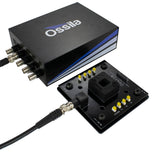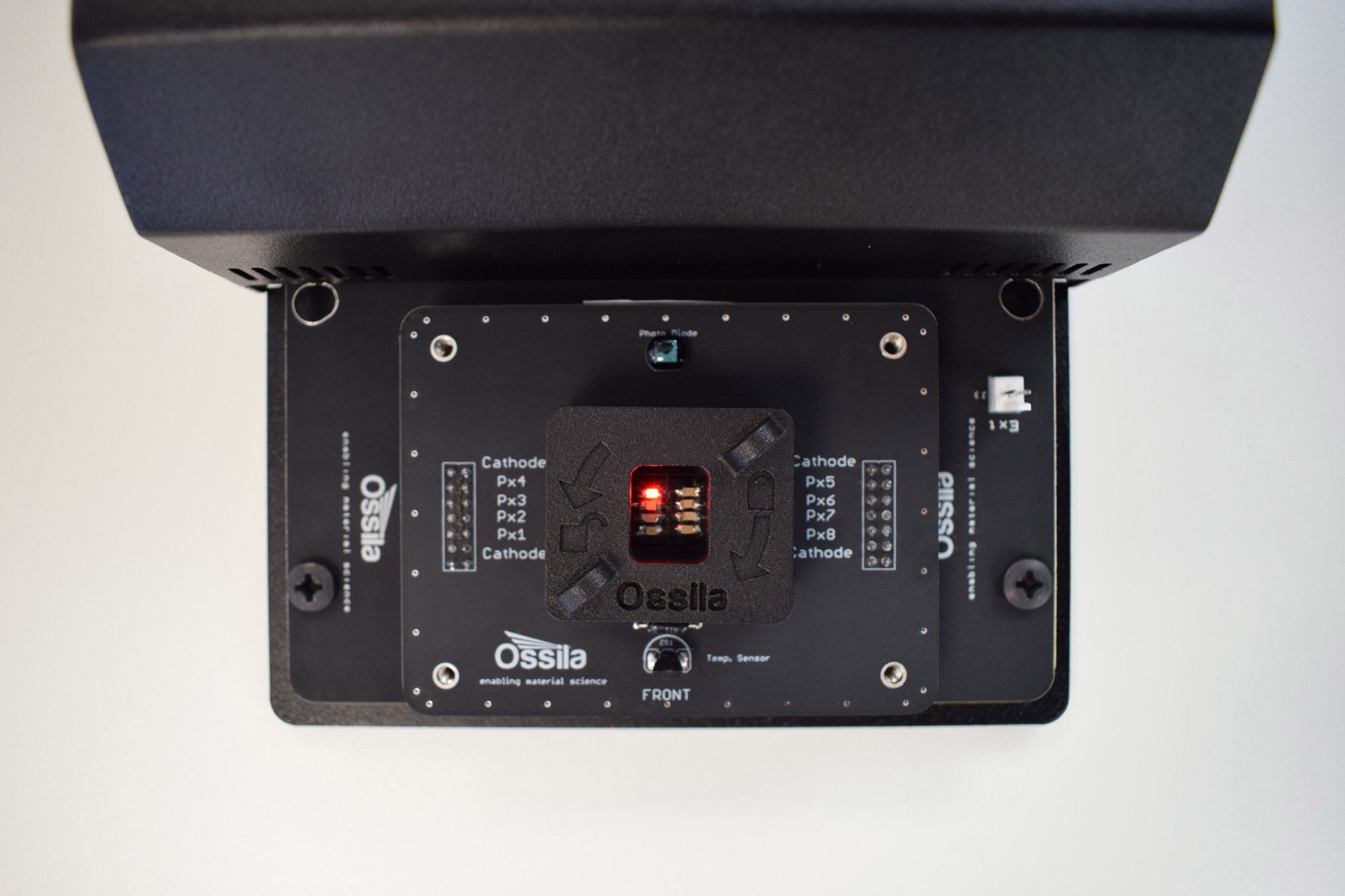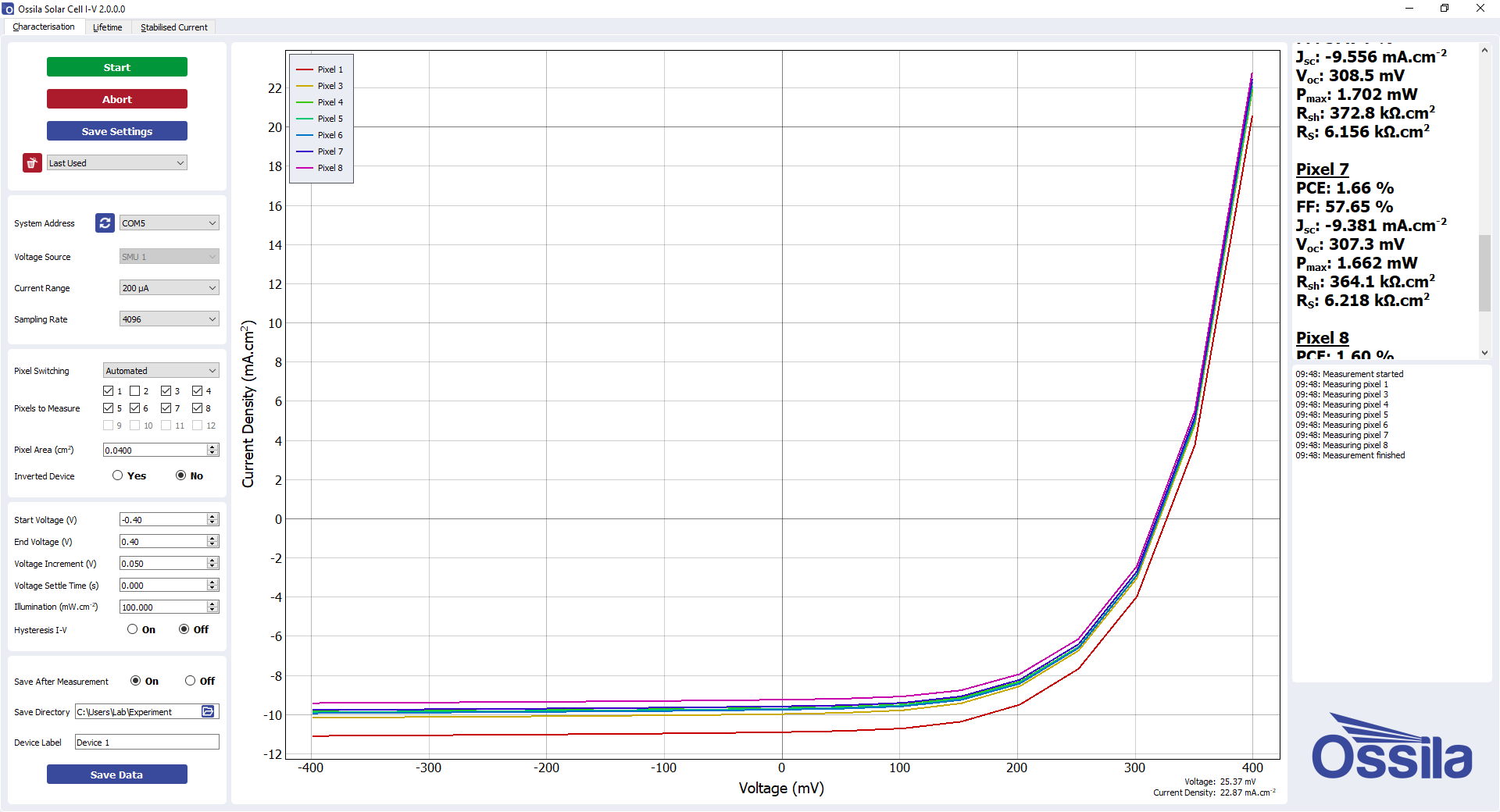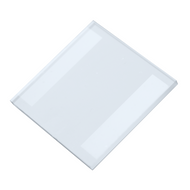Solar Cell I-V Test System
Lab Equipment, Solar SimulatorReliable and Accurate Characterization of Photovoltaic Devices
Take control of your solar cell measurements — no programming knowledge necessary
Overview | Specifications | Gallery | Software | In the Box | Accessories | Resources and Support
The Ossila Solar Cell I-V Test System is now available as complete kit with the new Ossila Solar Simulator. Order yours today and start characterizing solar cells with ease!
The Ossila Solar Cell I-V System is a low-cost solution for reliable characterization of photovoltaic devices. The PC software (included with all variants of the system) measures the current-voltage curve of a solar cell and then automatically calculates key device properties. In addition, I-V measurements can be performed periodically over time to track the stability of these properties.
The system is available with either manual or automatic pixel switching (if you are using one of Ossila's substrate systems), or without a test board for use with your own substrate and testing system or if you already own one of our test boards. Please refer to the table under the specifications tab if you are not sure which model you should choose.
Two-Year Warranty
Buy with confidence
Great Value
Reliable characterization of PV devices
Free Software
Fully customisable measurements
Range of Measurements
Wide voltage and current measurements
Specifications
Voltage Source
| Range | Accuracy | Precision | Resolution |
|---|---|---|---|
| ± 10 V | 10 mV | 333 µV | 170 µV |
Voltage Measure
| Range | Accuracy | Precision | Resolution |
|---|---|---|---|
| ± 10V | 10 mV | 50 µV | 10 µV |
Current Measure
| Range | Accuracy | Precision | Resolution | Burden |
|---|---|---|---|---|
| ± 200 mA | ± 500 µA | 10 µA | 1 µA | <20 mV |
| ± 20 mA | ± 10 µA | 1 µA | 100 nA | <20 mV |
| ± 2 mA | ± 1 µA | 100 nA | 10 nA | <20 mV |
| ± 200 µA | ± 100 nA | 10 nA | 1 nA | <20 mV |
| ± 20 µA | ± 10 nA | 1 nA | 0.1nA | <20 mV |
| Substrate Size | 20 mm x 15 mm 25 mm x 25 mm 75 mm x 25 mm |
|---|---|
| Substrate Compatibility | T2002B, T2003B – S211 T2002E, T2003E – S2006 T2002F, T2003F - S241, S251 |
| Overall Dimensions (W x H x D) – Automated | 150 mm x 55 mm x 300 mm (5.91" x 2.17" x 11.81") |
| Overall Dimensions (W x H x D) – Manual | Source Measure Unit: 125 mm x 55 mm x 185 mm (4.92" x 2.17" x 7.28") Test Board (T2002B/T2002E): 105 mm x 40 mm x 125 mm (4.13" x 1.57" x 4.92") Test Board (T2002F): 100 mm x 40 mm x 150 mm (3.94" x 1.57" x 5.91") |
System Selection Guide
The table below will help you determine which system is right for you. The manual version of the system has switches on the test board itself, which the user operates to measure the different pixels on a solar cell device. The automated version of the system uses a multiplexing test board, which switches between these pixels automatically. Test boards for the manual system and user-swappable riser boards for the automated system can be purchased separately.
| Substrate | |||||
| Pixel Switching | 
S211 |

S2006 |
S241, S251 |
||
 |
Automated - S211 (T2003B) | Automated - S2006 (T2003E) | Automated - S241/S251 (T2003F) | ||
 |
Manual - S211 (T2002B) | Manual - S2006 (T2002E) | Manual - S241/S251 (T2002F) | ||
Solar Cell I-V Test System Features
Calculates Device Properties
The included PC software automatically calculates key properties of solar cells from the measured I-V curves. These properties include: the power conversion efficiency (PCE), fill factor (FF), short-circuit current density (Jsc), open-circuit voltage (Voc), maximum power (Pmax), shunt resistance (Rsh), and series resistance (Rs).
Rapid Characterization
If you are using one of our substrate systems, the Solar Cell I-V System can be purchased with a multiplexing test board (just select the 'automated' variant of your choice in the drop-down list), which enables automatic pixel switching. As an added bonus, the temperature and light will also be recorded during the measurement!
Easy to Use
Just plug in the system, install the PC software, and you're ready to go! The intuitive interface and clean design makes the Solar Cell I-V System easy-to-use, simplifying the characterization of solar cells.
Wide Measurement Range
The built-in source measure unit is capable of delivering voltages between -10 V and +10 V, with a maximum resolution of 170 μV, and measuring currents from as low as ±10 nA up to ±200 mA.
Measure Device Stability
By performing repeated current-voltage measurements over an extended period of time, the stability of key device properties can be tracked.
Multiple System Types Available
Choose from our range of system types (automated or manual) depending on your requirements. If you are unsure which model to select, refer to our comparison table on the specifications tab or contact us for advice.
| System Type | No Test Board | Manual | Automated |
| ±10 V Source Range | Yes | Yes | Yes |
| 170 μV Source Resolution | Yes | Yes | Yes |
| ±200 mA Measurement Range | Yes | Yes | Yes |
| ±10 nA Measurement Resolution | Yes | Yes | Yes |
| Software Included | Yes | Yes | Yes |
| Automatic Solar Cell Characterization | Yes | Yes | Yes |
| Single Pixel Solar Lifetime Measurement | Yes | Yes | Yes |
| For Use With S2006, S211, S241, or S251 Substrates | No | Yes | Yes |
| Automatic Pixel Switching | No | No | Yes |
| Multiple Pixels Solar Lifetime Measurement | No | No | Yes |
A solar simulator is needed to obtain standard efficiency measurements. The Ossila Solar Cell I-V Test System is now available as a solar cell testing kit with our solar simulator.
Solar Cell I-V Test System Gallery

Software
The current-voltage measurement is controlled using intuitive and user-friendly PC software. All of the measurements can be fully customised, allowing you to tailor the software to your experiment.
With the PC software, you can:
- Perform current-voltage measurements anywhere between -10 V and 10 V.
- Take high resolution measurements, with voltage increments as low as 170 µV.
- Manage the experiment more directly, with custom settle times between applying voltage and measuring current.
- Measure device hysteresis by perform consecutive measurements in forwards and backward directions.
The software has 3 measurement tabs: Solar Cell Characterization, Stabilised Current Output, and Solar Lifetime Measurement. 'Characterization' performs I-V measurements and calculates the important device properties, the 'Stabilised Current' tab allows you to determine how the current output of your device evolves over time using, and the 'Lifetime' tab enables you to track key device properties (PCE, FF, Jsc, Voc) over an extended time by performing periodic I-V characterization. Between measurements the solar cell can be held at open-circuit, short-circuit, or maximum power.

Data is saved to .csv (comma-separated values) files, which are formatted to be easy to read and analyse. Settings are saved along with the data, making it easier to keep a record of the parameters used for each experiment. These settings files can be loaded by the program, and settings profiles can be saved for each different measurement type, allowing you to easily perform repeat measurements or use particular configurations.
Key Software Features
- Simple and intuitively-designed interface
- Data saved to .csv file
- Calculates solar cell properties (PCE, FF, Jsc, Voc, Pmax, Rsh, Rs)
- Track properties over time
- Measure the stabilised current output of a solar cell
- Save and load settings profiles

Software Requirements
| Operating System | Windows 10 (32-bit or 64-bit) |
|---|---|
| CPU | Dual Core 2 GHz |
| RAM | 2 GB |
| Available Hard Drive Space | 192 MB |
| Monitor Resolution | 1680 x 1050 |
| Connectivity | USB 2.0, or Ethernet (requires DHCP) |
In the Box
Automated System
- Automated Solar Cell I-V
- Riser board for substrate system of choice
- Resistor test device
- Power adapter (24 VDC)
- USB-B cable
- USB drive pre-loaded with the user manual, software installer, and quality control data
- USB Driver with QC test data
Manual System
- Source Measure Unit
- Test board for substrate system of choice
- BNC cable
- Resistor test device
- Power adapter (24 VDC)
- USB-B cable
- USB drive pre-loaded with the user manual, software installer, and quality control data
- USB Driver with QC test data
Accessories and Related Products




